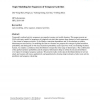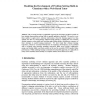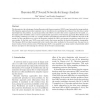331 search results - page 43 / 67 » Dining Activity Analysis Using a Hidden Markov Model |
ICDM
2009
IEEE
13 years 7 months ago
2009
IEEE
: Topic Modeling for Sequences of Temporal Activities Zhi-Yong Shen, Ping Luo, Yuhong Xiong, Jun Sun, Yi-Dong Shen HP Laboratories HPL-2010-160 topic modeling, LDA, sequence, temp...
JMLR
2008
13 years 9 months ago
2008
We study a generative model in which hidden causes combine competitively to produce observations. Multiple active causes combine to determine the value of an observed variable thr...
BMVC
2002
14 years 5 days ago
2002
A qualitative image description grammar with automatic image fitting and object modelling algorithms is presented. The grammar is based on assigning a square sub-region of an imag...
ITS
2004
Springer
14 years 3 months ago
2004
Springer
This research describes a probabilistic approach for developing predictive models of how students learn problem-solving skills in general qualitative chemistry. The goal is to use ...
PRL
2000
13 years 9 months ago
2000
We demonstrate the advantages of using Bayesian multi layer perceptron (MLP) neural networks for image analysis. The Bayesian approach provides consistent way to do inference by c...



